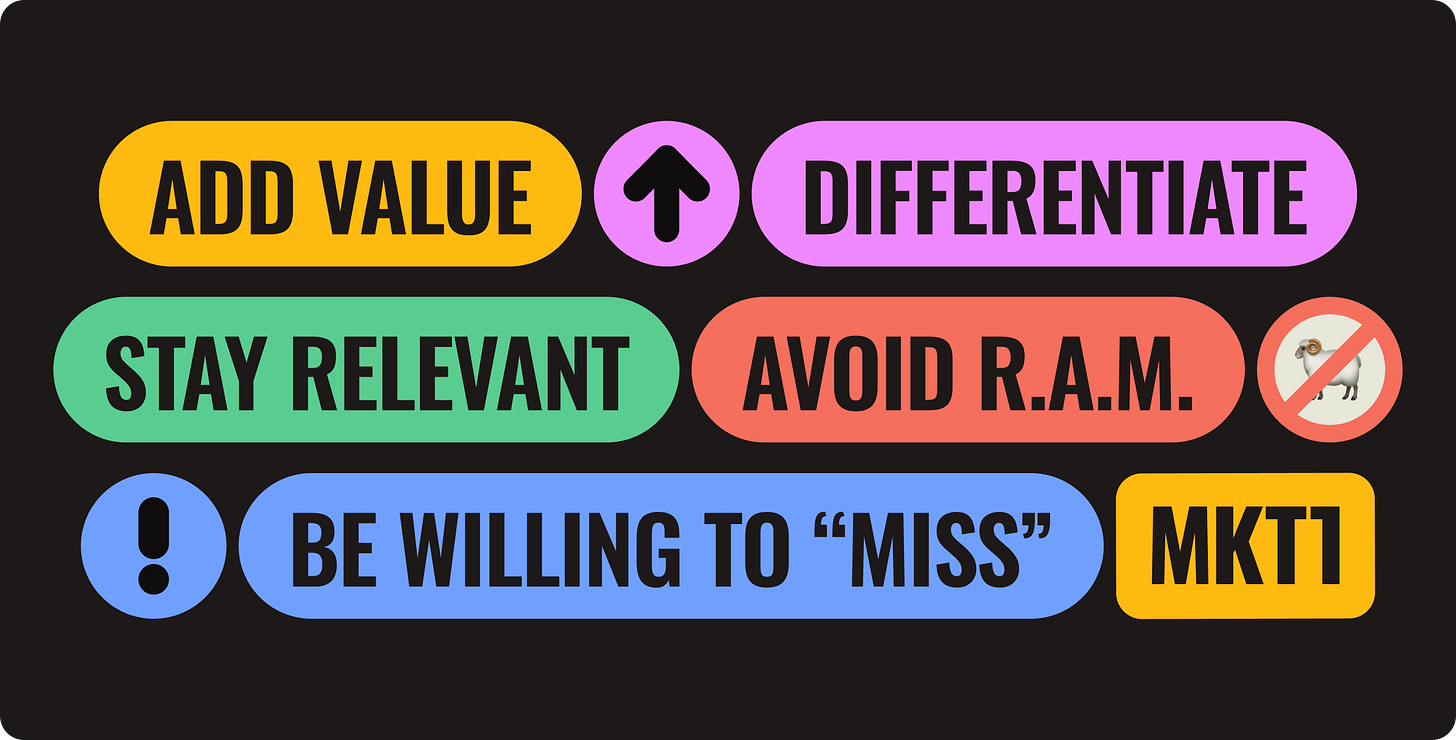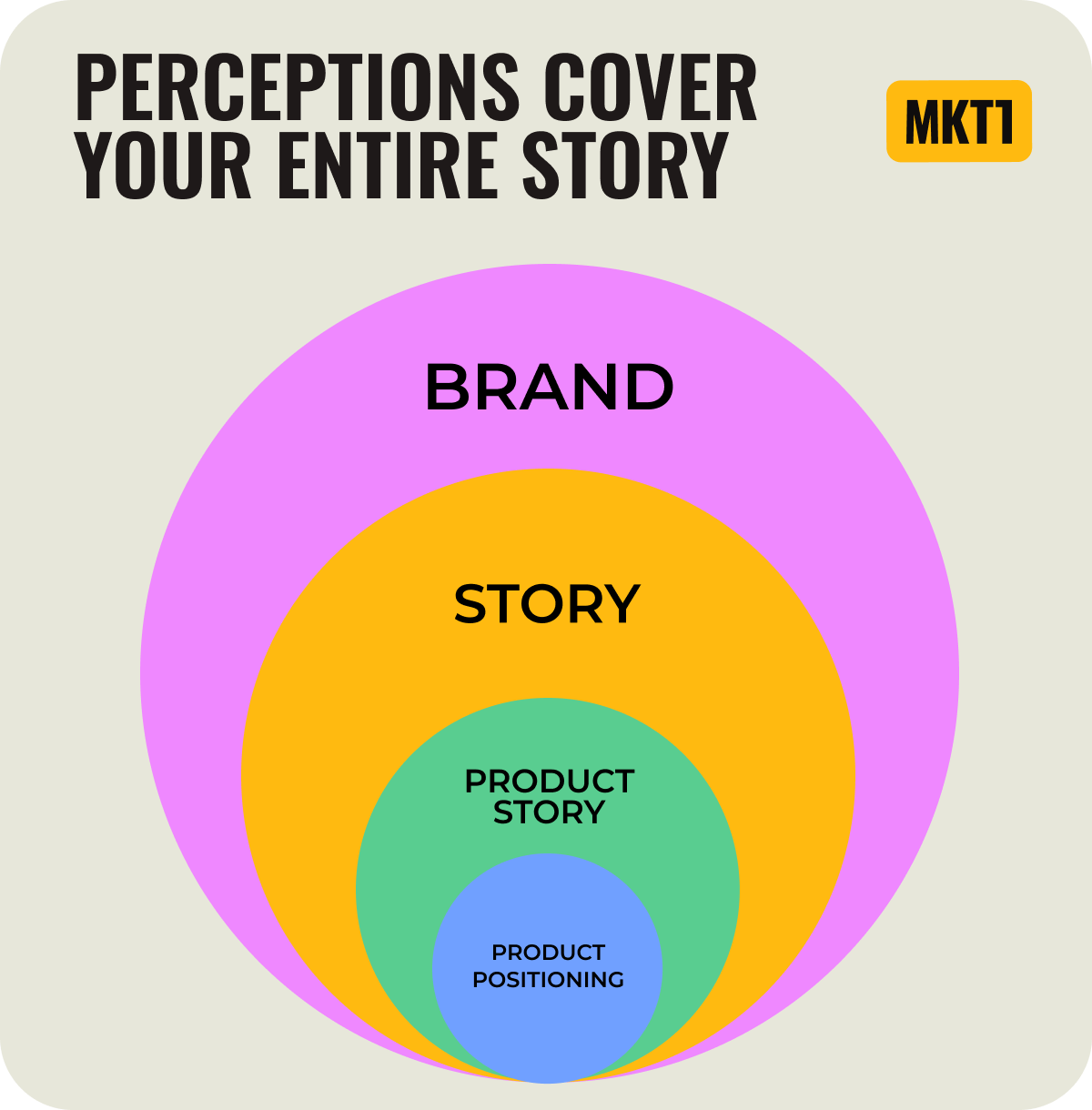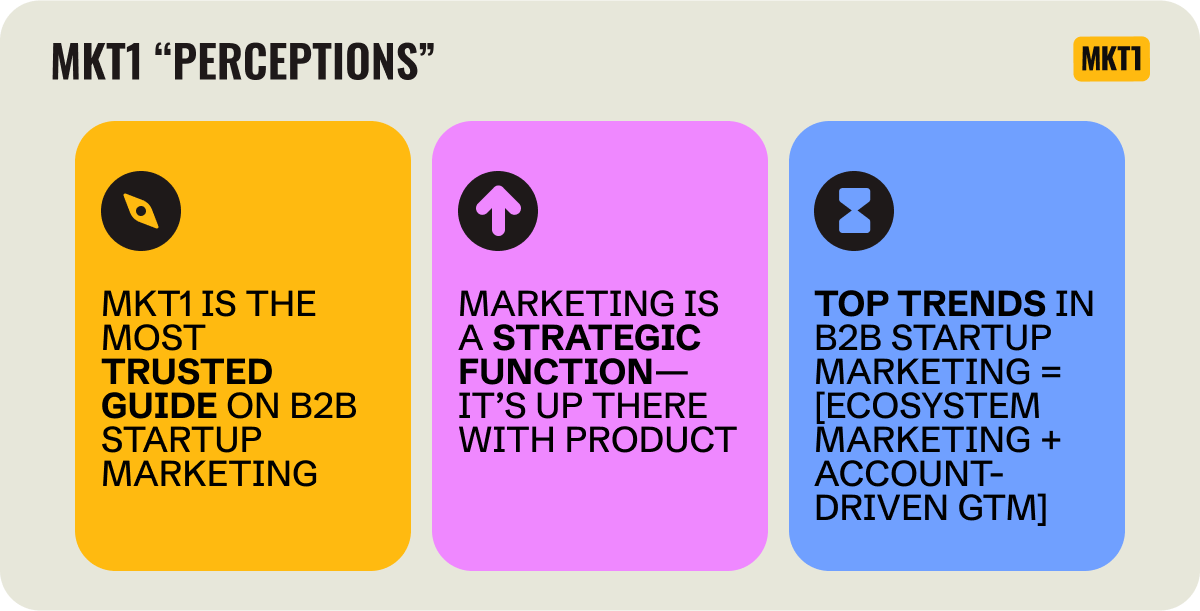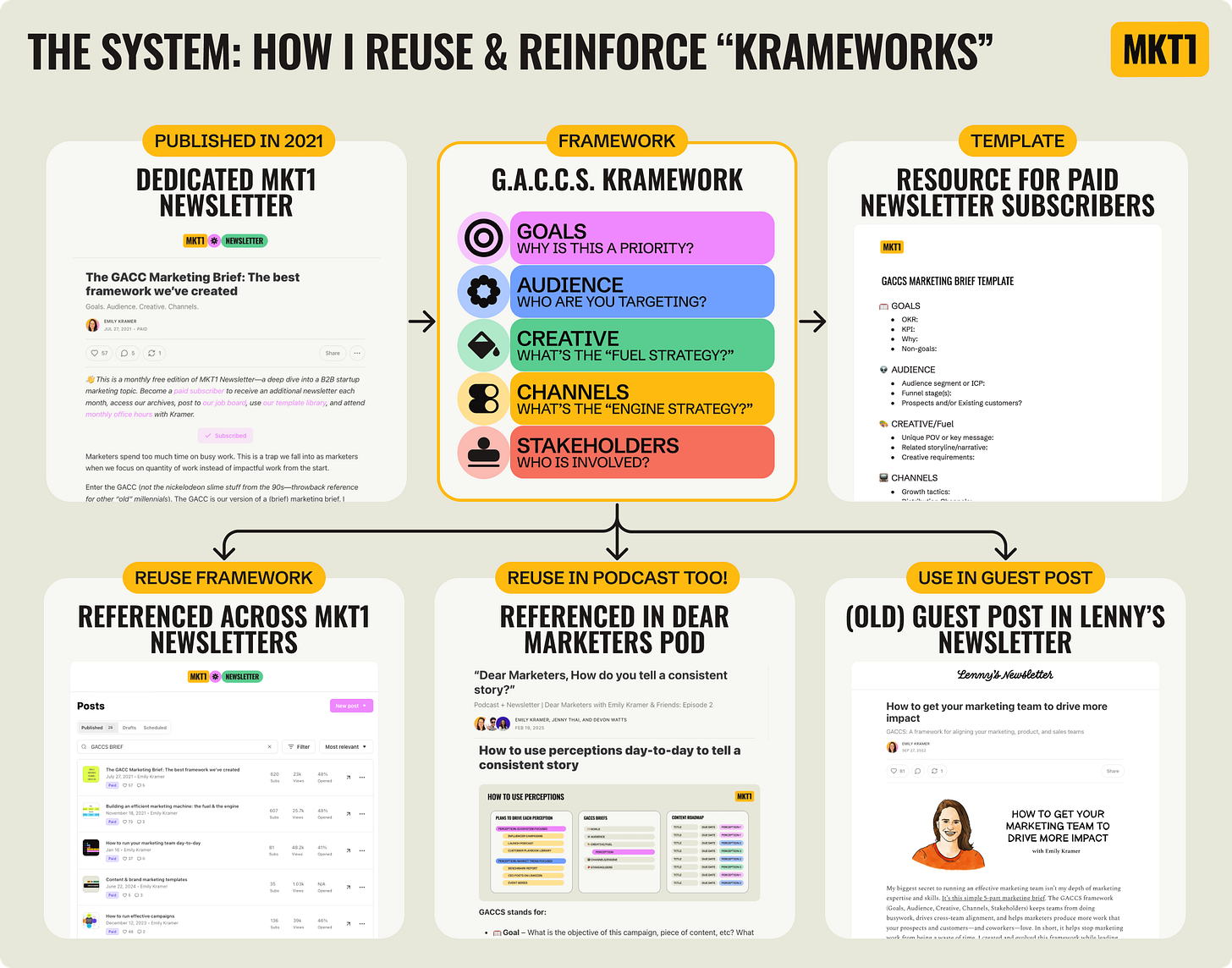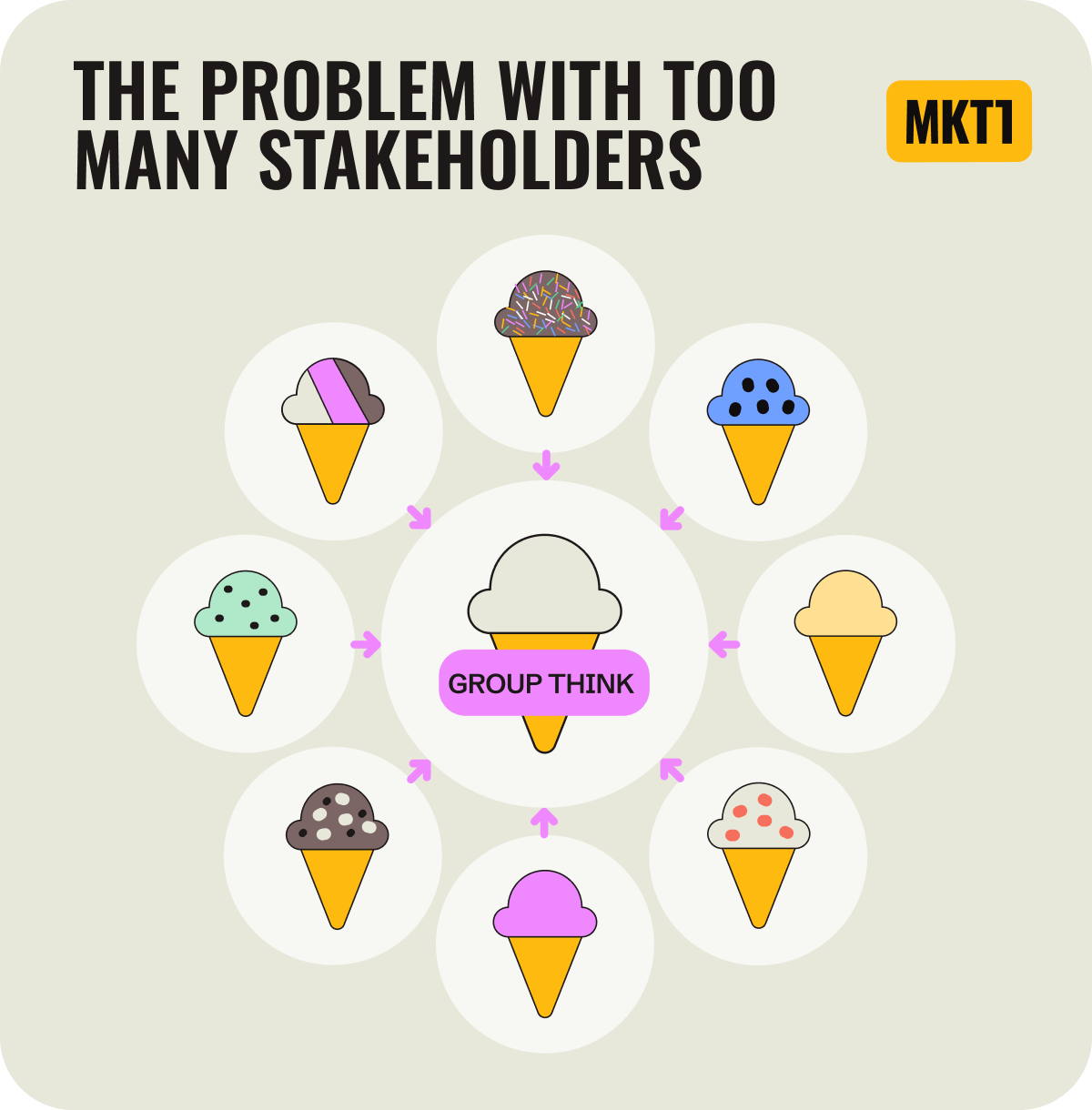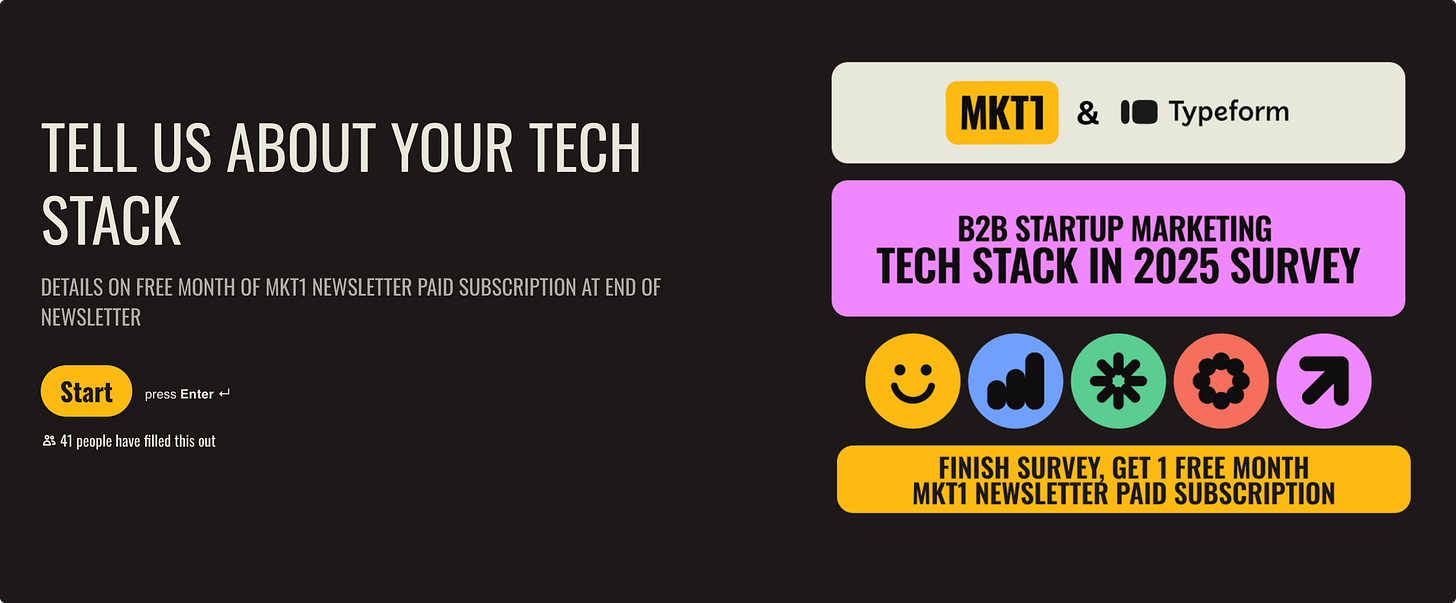
👋 This is a monthly free edition of MKT1 Newsletter—a deep dive into a B2B startup marketing topic, brought to you by Default, Ten Speed, and 42 Agency. Become a paid subscriber to receive additional newsletters, access our archives, post to our job board, and access our template library.
This newsletter is definitely “inside baseball”: I’m sharing how the very lean MKT1 content operation drives outsized impact. By walking through how I’ve built and execute on my content strategy, I hope it helps you create a “fuel” strategy for your B2B startup—even in 2025, when marketing feels like the wild west, with a drought one year and a storm the next.
While writing this, I did wonder if I sounded a little too obsessed with myself. But the truth is, my monthly reach—in terms of audience, views, and revenue—now surpasses that of many venture-backed startups I’ve worked with. That made me realize this might actually be useful. If I can hit these numbers with a team currently including just me, Katie Mitchell part-time, and our podcast producers at Caspian Studios, you can create content that drives real business growth too.
As you read this, remember: marketing content is a product. In my case, my content is quite literally a product I monetize through subscriptions and sponsors. But this same mindset applies to how you should approach content at your B2B startup. Use this newsletter as an example of what it looks like to bring product-like thinking to content strategy and creation.
In this newsletter:
I’m “open-sourcing” my content strategy or telling you how the (vegetarian) sausage is made. This is a 2-part newsletter because I realized there was quite a lot to all of this 4.5 years in!
Which reminds me, you don’t need to have your whole content strategy and system figured out from day one. You can start small and still drive a lot of impact by having a basic foundation in place, and evolve your content system over time—which is exactly what I did.
If you apply similar processes to your venture-backed startup, you can succeed at this too. Yes, even with SEO declining (search is a small part of what drives my growth, I always meant to put more effort in there, but maybe I’m glad I didn’t?)
My guiding principles for making content that’s differentiated and valuable
How I define and use perceptions and content pillars
No dead ends: How I reuse my frameworks (aka “Krameworks”) to reinforce ideas, make content creation easier, and drive growth & revenue.
Part 2 (later this month), subscribe to get this in your inbox
My actual content calendar setup for newsletters, podcasts, and LinkedIn
My monthly theming strategy, built around 1 primary piece of content
How I repurpose content across formats without burning out
For paid subscribers: perceptions template, gaccs template, and content roadmap template, contractor & agency list & discounts on tools
Note: While I imagine this newsletter will be valuable to other creators or marketers looking to go solo, like all my content, it is very much intended to guide marketing at B2B startups.
Recommended products & agencies
We only include sponsors we’d recommend personally to our community. If you are interested in sponsoring our newsletter, email us at [email protected].
Default helps you turn inbound leads into revenue with easier routing, immediate enrichment and faster scheduling. And they just launched website intent automations too, so you can detect and route qualified website visitors to the right reps.
🎁Offer: Mention MKT1 to get $1,000 off and free migration.
___
Ten Speed: If you’re looking to speed up your own content plans, reach out to Ten Speed. They partner with startups (including my advisees) on organic growth, full-service SEO & content marketing.
🎁 Offer: Mention MKT1 to get $1,000 off your first month.
___
42 Agency: From routing logic to fixing scoring, and aligning Hubspot + Salesforce —42 Agency handles the MOPS work your team avoids. 42 Agency is ready to help your B2B startup scale MOPs and paid campaigns.
🎁Offer: Mention MKT1 to get a free 30 min MOPS support call-–they’ll troubleshoot an issue or audit your set up (available for first 10 startups)
MKT1 content strategy foundation
Nothing I create starts from scratch. Everything is rooted in a (flexible) system that helps me decide what to talk about and how to talk about it. This system also makes it easy to extend one idea into multiple valuable pieces of content. What I’m saying is, there’s a method to the madness…most of the time.
Here’s what’s in my foundation:
Guiding principles
Content pillars or focus topics
Layered content and resource types, aka “no dead ends” appoach
You need a very similar set of things in your foundation. Don’t skip doing this because you think it’s too soon, your team is too small, or you don’t produce enough content. Even with just 1 (or 1.5 people), this is valuable. And while I’ve written about many of these topics before, but hopefully sharing my own examples will help you build your foundation more easily.
Guiding principles for MKT1 content
Before I talk about how I plan and make my content, I thought I’d share my principles. Usually I say don’t copy playbooks, but in this case if you adopt these exact same principles, I think you’ll go far.
1. Add value, every time
Guiding principle description for MKT1: Every LinkedIn post, every newsletter, every template, every podcast, try to add something new to the conversation.
How to implement this principle:
Remember, adding value takes many forms. As I mentioned in this podcast and newsletter, there are lots of ways to contribute thoughts or add to conversations. You can add a net-new thought, build on someone else’s thought in an interesting way, or synthesize a whole bunch of thoughts. You can ask thought-provoking questions. You can share things that are not exactly informative, but instead purely entertaining, and I’d still consider that valuable.
The flipside is also true: You shouldn’t be creating content just to fill a slot on a calendar. If you’re not adding value with a new piece of content, consider not creating it at all.
And most importantly, I believe quality and consistency matter. Consistency doesn’t mean publishing the same day every week though (I’ll never be good at that). It means people should know what to expect from you, and get it.
2. Stay relevant; know my audience and ecosystem
Guiding principle description for MKT1: Keep advising and meeting with founder of GTM tech companies to be able to keep creating the most relevant, high quality content for B2B startup marketing leaders. Without doing this, I’ll lose sight of what’s happening and become irrelevant quickly.
How to implement this principle: For you, this likely means actually watching those sales call recordings, reading support feedback, having direct conversations with prospects and customers, consuming info from influencers in your space wherever it is they hang out (LI, Reddit, industry events, etc).
3. Differentiate
Guiding principle description for MKT1: Share the deepest dives possible on B2B startup marketing topics. Give the high-level strategy or the why, give the how, and actually share the templates and resources to do this.
How to implement this principle:
Your product needs to be differentiated, but so does your content.
This starts from knowing who you are, testing and iterating, and not letting things get diluted by review committees.
What is that thing your company is uniquely suited to do in marketing? For me, I’ve found a gap in content in the ecosystem and something I’m uniquely suited to do with my deep dives. I’ve built multiple marketing teams from scratch at different stage startup, and led them at scale. I’ve worked with founders, VCs, and marketers from 100s of companies (and I’ve been in all those roles myself). This is a 360 perspective not many have, and I’ve leaned in.
4. Be willing to “miss”
Guiding principle description for MKT1: If you aren’t trying new things in marketing regularly that could “fail,” you aren’t doing things that are differentiated. You won’t break out of your current trajectory of growth. You won’t find your step-change drivers.
How to implement this principle:
Content is a “portfolio strategy,” like investing. Make sure every investment has a chance of winning, but recognize that only a couple will win and drive outsized returns.
You might be wondering: can you add value (principle 1) and still be willing to fail (principle 4)? I think so. Something can be genuinely valuable to a specific segment of your audience, even if it doesn’t land broadly or isn’t worth repeating.
5. Avoid random acts of marketing
Guiding principle description for MKT1: Don’t try too many brand-new things at once.
Try for one “big new thing” test at a time. Right now it’s the podcast.
This summer, my “big new thing” is bets on new types of resources for paid subscribers. And this fall it’s a larger bet on community events.
How to implement this principle:
The flipside of being willing to fail and testing new things is going overboard. You can try too many things and can stray too far from your core competencies.
Which leads me to this warning: Following other principles on this list can lead to falling into the random acts of marketing trap 🐏. Don’t let this happen!
You can also fall into this trap by knowing your audience and ecosystem, and wanting to do everything everyone else is doing. This is tempting, but don’t do that. I personally have to remind myself of this all the time.
Example: While it might seem like I do “copycat” things like launching a podcast, I spent years ruminating on the best podcast format that was truly “me” before launching it.
MKT1’s “Perceptions”
Perceptions template for paid subscribers here »
Telling a consistent and differentiated story starts by defining it. And to define it, you need perceptions.
Definition: Perceptions are the key narratives you want your audience to associate with your company and echo back to you. They are written from the perspective of your audience. They are the ideas you want to drive in your market. They are the foundational tenets of your story, guiding your marketing efforts to ensure a cohesive and repeatable message.
This clip is a primer on perceptions from Dear Marketers Podcast episode 2:
My perceptions
As you read through my 3 perceptions below, you’ll notice they’re not perfectly parallel—that’s intentional. One is how I approach MKT1 content, one is about the marketing function across companies, and one is about trends in marketing. Yours should be just as holistic. Together, they should capture the full story you want to tell, not just your product story.
Perception 1: MKT1 is the most trusted guide on B2B startup marketing
Perception description: MKT1 content should feel like guidance first and foremost, and “the guide” should feel like a real person (weird jokes and all) because it is a real person. The content is opinionated, in-depth, and consistently so.
Note to self: Be Apple, not Android. Nothing against Android, but MKT1 is all about “vertical integration.” My single, consistent point of view and editorial voice goes across everything. It’s not a mix of contributors or styles. That approach works for others, but it’s not what makes MKT1 work.
How MKT1 drives the perception:
Maintain a clear point of view and strong editorial voice from Kramer across everything. (e.g. no guest posts unless I can add commentary)
Keep quality high and extremely in depth, no short-cuts. Every post doesn’t need to be 3,000 words, but I should always try to explain the why and how.
Reinforce familiar frameworks and point of view consistently, build trust by showing up with practical, thoughtful guidance (not just hot takes), be generous with resources that make marketers’ jobs easier
Where this perception “shows up”:
Everywhere: MKT1 newsletter, Dear Marketers Podcast, LinkedIn, events, speaking opportunities
In my tone: direct, confident, strategic, occasionally weird
In my ever-growing and improving template and resource library
Sponsors that are highly vetted, with copy written by Kramer, not the sponsoring company
Emerging sub-perception: MKT1 is becoming the best place to discover marketing contractors, agencies, tools, jobs, and candidates. I’m driving this through our sponsors and discounts, a vetted contractor list, my job board. Our big bets this summer revolve around doing more here!
Perception 2: Marketing is a first-class, strategic function—it’s up there with product
Perception description: The best products don’t always win; a differentiated product plus differentiated marketing is necessary to win. And B2B startups with thoughtfully built marketing functions plus marketers with a voice at the leadership table are best suited to do this.
Sub-perception #1: Marketing teams are more like product teams than sales teams.
Sub-perception description: Marketing isn’t just a service function to sales (or any other team). The best marketing teams operate more like product orgs than sales orgs.
Sub-perception #2: Marketing content is another product your company makes.
Sub-perception description: A successful content strategy solves problems for your audience in a differentiated way, much like your product. And your content library is a diversified set of assets you should maintain, build on, and prune just like a set of product features.
How MKT1 drives the perception:
Be a personal example of just how strategic marketers can be, while helping others become more strategic and get better at thier ujobs
Champion strategic marketers and marketing publicly, while highlighting the strategic value of the role
Help marketers explain what they do to non-marketers: Use analogies and frameworks to explain the complexities and nuances of the function to those who don’t understand it or simplify it. (e.g. marketing = product; marketing requires fuel & engine)
Where this perception “shows up”:
This was one of my huge goals for MKT1 from the beginning. I’ve tried to champion marketers and elevate the “perception” of the function through everything I’ve done, from raising a fund that helps startups with marketing, to teaching marketers in courses, to writing this newsletter, to speaking lots of places
Here are a few newsletters where I’m explicitly trying to drive these points home over the years: B2B Marketing org charts | "Dear Marketers, how do you hire a great team?” | Does every marketing channel *actually* suck right now? | Modern marketing looks a lot like…product? | 4 Ways marketing is different from sales
Note: If you’ve heard me say “marketing is a product” or “build marketing like product” a million times (including in this newsletter), that’s by design. Repetition builds the perception.
Perception 3: Top trends in B2B startup marketing = [ecosystem marketing + account-driven GTM]
Perception description: Be a couple steps ahead of trends and lead the conversation around the most important shifts in B2B marketing. Right now, that means: “Ecosystem marketing is the next big channel” and “Every company should build GTM on an account-driven foundation”
How MKT1 drives the perception:
I revisit these perceptions 1–2 times per year, and may update the trends in the brackets. But when I commit, that’s what I double down on across everything
Create deep content around the trends: newsletter series, templates, podcasts, social
Prioritize events, guest spots, and collaborations that reinforce these themes, don’t be afraid to turn other stuff down
Reuse and repurpose content across formats to keep them front and center. Get to the point where I feel like a broken record, at that point I’m probably saying just the right amount.
Where this perception “shows up”:
For the sake of showing how this all works, here are a few instances over the last 6 months where I’ve talked about these trends:
Account-driven GTM:
3-part newsletter series on account-driven GTM + new templates + account-driven tool list
Panel discussion at Mutiny’s CMO event in May
Multiple LinkedIn Posts: Account-driven GTM is like organizing clothes, Seismic shift in GTM
Ecosystem:
Ecosystem marketing 2-part series in Fall 2024
Dear Marketers podcast episodes: “Should your founder be an influencer?”, plus 1-2 more in the back half of Season 1 focused on ecosystem
Guest appearance on Anna Furmanov’s podcast on ecosystem - coming soon
Chat with with Mallory Contois (and newsletter) focused on changing marketing channels and the rise community marketing
Sponsored Linkedin Post: How we use Attio to manage our ecosystem efforts at MKT1 (yes I stuck to theme with a sponsored post!)
Regular Linkedin Posts: Using Composition & Coverage concepts in ecosystem marketing
Content pillars: Planning my topics in advance
You can’t tell a cohesive story if you don’t know your topics. Content pillars, aka main topics or themes, are the core ideas your company consistently covers. Think about not only what your product does, but also the problems you solve, the use cases and solutions you bring to your audience, and all the things your audience cares, including the things outside of using your product (think about that diagram of concentric circles in your story I shared above).
Are content pillars the same thing as perceptions? No, but there can be overlap if one pillar is so important that it ladders up to the level of an overarching storyline you are trying to get your audience to repeat back to you.
E.g. In my strategy, ecosystem marketing is a content pillar, and also part of a perception. This trend is so important I want to talk about it enough that people associate it with MKT1.
I think of my “content pillars” as the chapters in the MKT1 book on B2B startup marketing (no, I’m not writing this book, or any book). Four years ago, the book was kind of short. It started as a book about designing and building marketing orgs. We (Kathleen when she was a full-time part of MKT1 & I) wrote about org design, then hiring your first marketer, then the product marketing role—but we knew our “book” would cover more than just roles on a marketing team.
It’s fine if your book starts short too. You won’t have everything I describe in this newsletter on day 1. But it’s important to start on your perceptions and pillars as soon as you can.
Here’s how my content pillars evolved and grew over time:
I knew I could cover all of B2B marketing strategy, but thought writing a few things on a niche (organizing and hiring marketing teams) would really help me build subscribers initially.
I then started covering all of early-stage B2B marketing strategy, then expanded to growth-and late-stage startups as I shifted how I spent my time from early-stage investing to growth-stage advising. Your book will grow and slightly pivot, too, as you see what content “works,” cover more stages of the customer lifecycle, expand your ICPs and products, and grow as a team.
Sometimes it will feel like a messy outline of book chapters, sometimes that list of “content pillars” will feel like the chapters of a tight cohesive bestseller. It ebbs and flows.
For me, you can tell my “book” is feeling very cohesive when I put out things like “MKT1 Method” that included a one-take Loom video.
But anyway, the book has pretty well-defined chapters now, though who knows, maybe I’ll add some more. So now, when I’m creating content, I try to get breadth and coverage across the “book”. This doesn’t mean within each piece of content, but instead over a period of a few months.
Breadth: Am I covering the full range of topics in my “book,” aka content pillars?
I mainly try to cover “fuel” and “engine” and broad management and strategy topics in equal amounts over 3–6 months. So 33% to each. But I never actually do the math, it’s just a back of the envelope sorta thing.
Depth: Am I reinforcing the perceptions I want to drive right now?
The depth areas are easy to find, it’s the overlap of content pillars with perceptions. So for me right now, that’s on marketing orgs being a strategic function (well, that one’s always on) and ecosystem marketing and account-driven GTM.
Here are my content pillars:
B2B marketing functions: Growth marketing/demand gen; Marketing/RevOps; Product marketing; Ecosystem marketing: Partner, customer, influencer, community, etc; Events; Content marketing; Creative/brand; Social
Strategy & processes across all of marketing: Planning & goal setting; Org design & hiring & getting hired; Marketing management; GTM tech and how it works; Team process; Cross-functional initiatives and campaigns; Cross-company alignment and relationships
My core “Krameworks”/principles that run across these areas: “No playbooks”; “Avoid Random Acts of Marketing” / Impact > RAM; “Fuel & engine”; Organizing around “GACCS” (goals, audience, creative, channels, stakeholders) briefs
How this shows up across my content:
Substack categories/navigation: All my newsletters are tagged by pillar
Dear Marketers Podcast season 1: Built to span these topics
Template & resource library: Organized around the same categories, we have a post for templates that fall into many of these pillars
Monthly content roadmap: Newsletter placeholders on the roadmap usually start as just a content pillar, then the topic sharpens closer to publishing
“No dead ends”: My system for connecting content & earning engagement
There’s a tension when creating marketing content. On one hand, you want it all to connect in a perfect journey. On the other, you know prospects don’t follow a linear path. So I think about content through the lens of “no dead ends.” If someone wants more, I give them more. If they don’t yet want more, I try to encourage them want more.
Here’s how that shows up:
Clear CTAs
This isn’t a groundbreaking idea, but it’s not just about linking to something—it’s about linking to something valuable.
For me, this means not just asking people to subscribe to the paid version of the newsletter, but sharing detailed diagrams and screenshots of templates that are valuable on their own. Plus I share events, additional reading, and even jobs at the end of the newsletter to keep you engaged even if you aren’t ready to become a paid subscriber.
For B2B startups, that might mean: Don’t just run an event and immediately push for a demo. Give people something else useful as the next step. Maybe a follow up resource mentioned during the event. Earn each next step.
Framework reuse
I introduce new “Krameworks” (frameworks made by Kramer) in my monthly, long-form newsletters like this one. (“No dead ends” is a new Kramework, by the way.) Then I reuse and reinforce these frameworks in future content.
We even have a special sound for Krameworks on the podcast. When you hear it, that’s likely me re-using and reinforcing something I’ve made before. It’s also just kind of fun and stupid, like the name “Krameworks” itself.
These frameworks aren’t standalone ideas, they’re tied to my content pillars. And when a Kramework needs more than just a well-written explanation and a beautiful Figma diagram, I build a template or resource to help people actually use it. Those templates are part of the product I offer to paid subscribers.
Each Kramework then isn’t just a concept, it’s something people can implement. That’s how I deliver value and drive subscriptions without sounding overly salesy (at least I hope).
This system makes creating “new” content easier
When I make new things, I try to reinforce, reuse, and connect the dots more so than just churn out brand new ideas.
Take my new podcast as an example. I rarely introduce new frameworks in an episode. The “net-new” thing is the conversation itself, grounded in my existing content pillars and perceptions. When I prep for an episode, I usually list a few frameworks to reference in the doc I send to co-hosts. And since I’ve built and reused these frameworks for years, I don’t have to go digging, they’re already second nature. This is a huge advantage of a small team.
Honestly, it’s kind of like writing a TV show…I think. There are the main characters, the settings, the small plot-lines; those are the content pillars. The perceptions are the main story arcs. The frameworks are the quirks or catchphrases that keep things consistent and recognizable. Yes, this would be a very boring TV show, but the analogy still holds?
Why my stuff “works”
I just dissected my process in a lot of detail, with a goal of informing and guiding some evolution and upgrades to your own process. It might seem complicated. But it’s not, really. I build enough infrastructure and process to know what I’m writing about and try to reuse similar concepts to both reinforce ideas and make my life easier, win-win!
And the other reason it works? I have a clear point of view and editorial voice. Without that, content becomes vanilla. And no one wants to subscribe to vanilla. Especially not me.
Not coincidentally, I talk about groupthink and too many stakeholders leading to producing vanilla ice cream in my podcast episode coming out later this week. So the idea of groupthink, AI-generated content, and overly reviewed content leading to vanilla-ness is shaping up to be a repeat concept or Kramework across the MKT1-verse. The process I just described is happening before your very eyes…so you’ll get to see this group-think ice cream diagram 2 newsletters in a row!
To be continued…
Part 2 is out later this month. I’ll walk through exactly how I create my newsletter calendar, my podcast calendar, and my LinkedIn calendar—and how I repurpose content across them all.
Like most MKT1 content, it will be created to be something you can “steal” and actually implement.
Subscribe so you don’t miss it.
MKT1 & Typeform Survey
I’m running a survey with Typeform to find out what tools you are obsessed with right now, what you can’t wait to try, what the most important tools in your tech stack are, and more. This will inform a newsletter this summer.
Bonus: If you fill the whole thing out (takes 3-4 minutes), you’ll get a free month of MKT1’s paid newsletter subscription for yourself or a marketing friend.
More from MKT1
🙏 Thanks again to our sponsors: Default for automating inbound workflows; Ten Speed: an SEO & content agency, and 42 Agency: a RevOps and paid media agency. All three have offers for MKT1 subscribers!
📰 Next newsletter: Part 2 of “Behind-the-scenes: The MKT1 content strategy” will hit your inbox later this month.
🎙️ Next podcast: Dear Marketers Episode 7 is out Friday or Monday (I’m feeling non-commital), answering the question “Should you do a web or redesign?”
💰 Discounts list: Discounts on recommended products and services, exclusively for paid subscribers.
🧑🚀 Job board: Jobs from the MKT1 community



